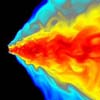| . |  |
. |
University Park PA (SPX) Mar 14, 2005 Black holes have a reputation for voraciously eating everything in their immediate neighborhood, but these large gravity wells also affect electromagnetic radiation and may hinder our ability to ever locate the center of the universe, according to an international research team. "Any attempt to discover what was happening a long time ago at the beginning of our universe must take into account what gravitationally assisted negative refraction does to the radiation being viewed," says Dr. Akhlesh Lakhtakia, distinguished professor of engineering science and mechanics, Penn State. Electromagnetic radiation is affected by the material through which it travels. A material with a negative index of refraction transmits light or other wave energy differently than one with a positive index of refraction. Natural materials have positive index of refraction. When an energy beam � light, radar, microwaves � passes through water or glass or some other natural material, the material displaces the beam in the same direction. The amount of displacement depends upon how different the material is from air or vacuum. The displacement, due to a material with negative index of refraction, is in the opposite direction. Previously, Lakhtakia and Tom G. Mackay, lecturer in mathematics, University of Edinburgh, used Albert Einstein's Special Theory of Relativity to examine refraction by moving materials. They calculated that negative refraction can be concluded to have occurred by an observer moving at a very high relative velocity in certain directions. Later they showed that no material is needed for negative refraction in outer space. Instead, when a beam passes through the gravitational field of a massive object such as a rotating black hole, negative refraction is theoretically possible. When it comes to the influence of gravity caused by rotating black holes or other massive objects, it really depends on where one stands. A local observer can only see a very small piece of the universal picture of how large gravitational forces influence electromagnetic radiation. To the local observer, gravity is uniform and does not cause negative refraction. However, Lakhtakia and Mackay, assisted by Sandi Setiawan, a postdoctoral researcher at the University of Edinburgh, decided to look at a global observer - one who stands in space-time as described by Einstein in his General Theory of Relativity. A global observer sees a region around rotating black holes, called the ergosphere, as possibly bending electromagnetic radiation according to a negative refractive index. These new derivations, reported in the March 7 issue of Physics Letters A, indicate that not only do the effects of the minute stuff of the universe have to be considered when mapping the universe, but the existence of large gravity wells must also be considered. "When we are tracking light, we must take into account gravitational forces," says Lakhtakia. "Although the effect is only significant very close to rotating black holes." The three researchers have extended their theory of negative refraction to even more general scenarios, in a paper published today (March 8) in the New Journal of Physics, an electronic journal. As we reach out in extrasolar space, for example via Pioneer 10, scientists are getting more interested in the actual existences of such scenarios. Normal light bending by a gravity source such as our sun is known as gravitational lensing. It has been suggested since Einstein's time and was experimentally shown by a British team of scientists in 1919. This gravitational lensing sometimes causes multiple images to be seen. The effect is taken into account in global positioning systems. However, this light bending is positively refracted. But, when we search for the origin of our universe, multiple black holes and other massive objects can make the light beams bend in unexpected and unpredictable ways. "We should not be disappointed if we cannot discover the origin of the universe," says Lakhtakia. "The gravitational effect probably makes it so that we do not really know where we are looking." Nevertheless, Lakhtakia and his collaborators are optimistic that scientists will eventually overcome many of the obstacles put forward by negative refraction in outer space. Related Links Penn State University of Edinburgh SpaceDaily Search SpaceDaily Subscribe To SpaceDaily Express
 Baltimore MD (SPX) Mar 08, 2005
Baltimore MD (SPX) Mar 08, 2005For more than 30 years, astrophysicists have believed that black holes can swallow nearby matter and release a tremendous amount of energy as a result. Until recently, however, the mechanisms that bring matter close to black holes have been poorly understood, leaving researchers puzzled about many of the details of the process. |
|
| The content herein, unless otherwise known to be public domain, are Copyright 1995-2006 - SpaceDaily.AFP and UPI Wire Stories are copyright Agence France-Presse and United Press International. ESA PortalReports are copyright European Space Agency. All NASA sourced material is public domain. Additionalcopyrights may apply in whole or part to other bona fide parties. Advertising does not imply endorsement,agreement or approval of any opinions, statements or information provided by SpaceDaily on any Web page published or hosted by SpaceDaily. Privacy Statement |